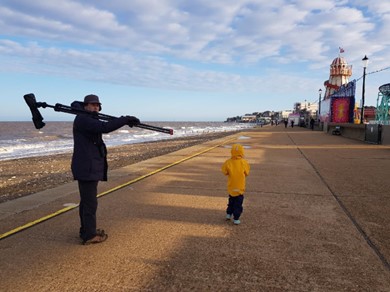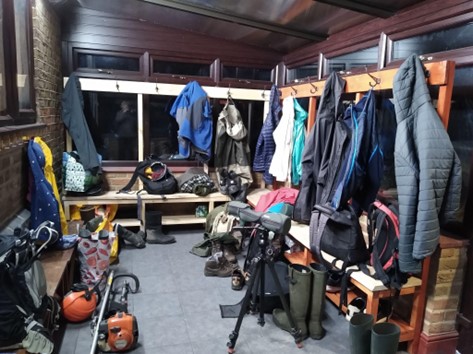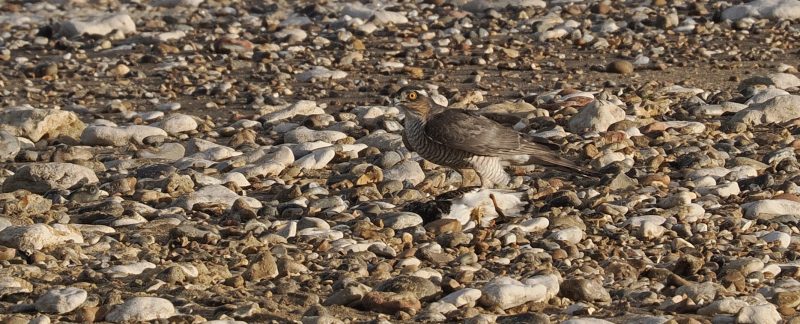Friday 13 / Saturday 14 October
A small team gathered on Friday evening. As there was no setting, we enjoyed a social, relaxed evening after Cathy’s delicious and sizable baked potatoes and fruit salad. Saturday morning were recces and resighting across all east shore beaches (Snettisham, both Heachams, and Hunstanton), but no fields. There was a strong onshore wind, but clear conditions, and we found out afterwards the tide made by 0.5 m. For all resighters, the strong wind hampered steady resighting. Various parties left to look at all of the beaches, arriving between 06:30 and 07:00 depending on the beach.
David’s team on Snettisham arrived at 06:20 and it was still quite dark to see anything. They walked up to Heacham dam and found 30 Grey Plover scattered along the beach in two flocks. Sanderling were mobile and hard to see at first, but when it became light enough to see there were about 250. Some strange windsurfers flushed everything just before 07:00, and the Sanderling all went to Heacham South where they had settled around 07:20 by the big yellow buoy. A few other things (Knot, Turnstone, etc) were also scattered in with the other birds on Snettisham. The group never saw the Grey Plover leave.
For resighting at Snettisham, by the sailing club at 09:00 the group had two Turnstone, and a couple of Curlew including a headstarted bird. On Snettisham beach around 10:00, the group had three Barwit and 13 more Curlew. At Heacham, Katharine’s team had 90–100 Sanderling sitting just north of the dam, probably different ones to the Snettisham flock (50 were already in place and 50 came in from the north). Once the mud finally exposed, Curlew and Barwit dropped in and immediately started feeding, with a good number of colour-marked individuals. This group also had a Black-throated Diver, 13 Whooper Swans, and one Arctic Skua.

At Heacham NN, Cathy’s team had very small numbers of Turnstones on the small bit of beach exposed. They then went north to Hunstanton South beach where they met with Nigel & Sam and watched a flock of about 40–50 Turnstone which had six colour-marked individuals. Once the mud and mussel bed started to expose, Oystercatchers came in and we also had about 170 Barwit, and a handful of Curlew and Blackwit. At Hunstanton, Nigel and Sam arrived by the Green and spotted Turnstone south beyond the amusement park. Any bit of exposed shingle had a few Turnstone, and by the time we got to Cathy’s team we had c. 50 Turnstone, 80% of which were juvenile, including six colour-marked birds. A Sparrowhawk shot over the seawall and grabbed a juvenile Turnstone which stirred everything up and then the Sparrowhawk and waders left. We then walked north towards the cliffs, where we found a flock of about 60 Turnstone below the cliffs, which were pushed along by some walkers. Notably, there was not a single colour-marked bird. A small flock of Oystercatchers and Blackwit were on the point below the cliffs.
There was no option for catching on Saturday afternoon, but there was an option for resighting. Cathy’s team went to Heacham, while Sam’s team went to Snettisham for 15:30. Cathy’s team had a quick look at the beach from the end of the walkway then walked quickly down the back of the beach between the houses to the gate, and then went onto the beach there. They continued south and then started resighting. As soon as they arrived, all birds to the north left (there was someone out on the water), so they had to walk further south to avoid having to look into the sun at birds. They resighted six Curlew, including 6N/O which is GPS tagged having been caught at Heacham in 2021.
Sam’s team went onto the beach at the Snettisham Ken Hill car park and had a few colour-marked Curlew straight away. Then they walked north towards a large mixed flock of Barwit and Knot, stopping occasionally to resight Curlew which were closer. The Barwit eventually got pushed up close enough to get a few flags before the whole flock lifted and headed south in groups. They then continued north to look at the proposed Sunday morning catch site and a position for the hide. On the way, we saw there was actually an Oystercatcher flock on the beach just south of the dam; they had clearly come up from the mussel scar after the mud covered. It wasn’t long before some walkers lifted them and they headed south however. We found a spot for the hide south of the net-setting site, and then headed back to the car. On the way, Meg spotted a strange, apparently swimming Sanderling along the tideline, but on closer inspection, it was a swimming Red-necked Phalarope along the tide edge in proximity to the Sanderling!
We all enjoyed a delicious dinner masterminded by Bob with Katharine and David’s help. The team left to set cannon nets at 21:00 on Snettisham just south of the usual spot and setting two nets went fairly smoothly apart from one item which was forgotten for the second time that weekend!

Sunday 15 October
The next morning, the firing position was up first and in position by 06:00, with base camp following not long after at 06:15. Unfortunately, the hide party found that with the firing position to the south of the net set on Snettisham, they were looking straight into the Hunstanton streetlights which meant they were pretty much blinded from getting an adequate view. Richard could see enough to tell that there were probably Grey Plover in the catching area, but the streetlights meant that he couldn’t see clearly. As the tide came up and it got lighter, the Grey Plover left and it was clear the tide was going to make again with a strong onshore wind, meaning the conditions were unsuitable for trying for Sanderling. We quickly made the decision to pull the nets up before they got wet and were very efficient in doing so.
While most of the team returned to the base house to unpack and sort kit and get breakfast on, a small group decided to whip down to the RSPB car park to look at Snettisham Pits and mudflats, considering the tide was likely to make again, meaning resighting could be quite good. We were glad we did, as there were about 300 Curlew and 1,500 Barwit in a large flock right off the viewing point by the benches, well within scoping distance. While many birds were roosting with one or the other leg tucked up, there was enough shuffling about so that combinations became visible and we were able to get a good number of Curlew and Barwit colour-marks. The flock hung around long after the mud was exposed, and we only decided to tear ourselves away once it started to get on past 11:00. Once back at the base, the late crew had the second sitting of breakfast and then everyone tidied up before heading home.
Resighting totals (all WWRG-ringed birds apart from the headstarted Curlew).
| Species | Encounters | Individuals |
| Bar-tailed Godwit | 15 | 15 |
| Curlew | 73 | 54 |
| Headstarted Curlew | 1 | 1 |
| Turnstone | 24 | 9 |
| Total | 113 | 79 |
Thanks to Sam Franks for writing this report. Cover image by Cathy Ryden.

